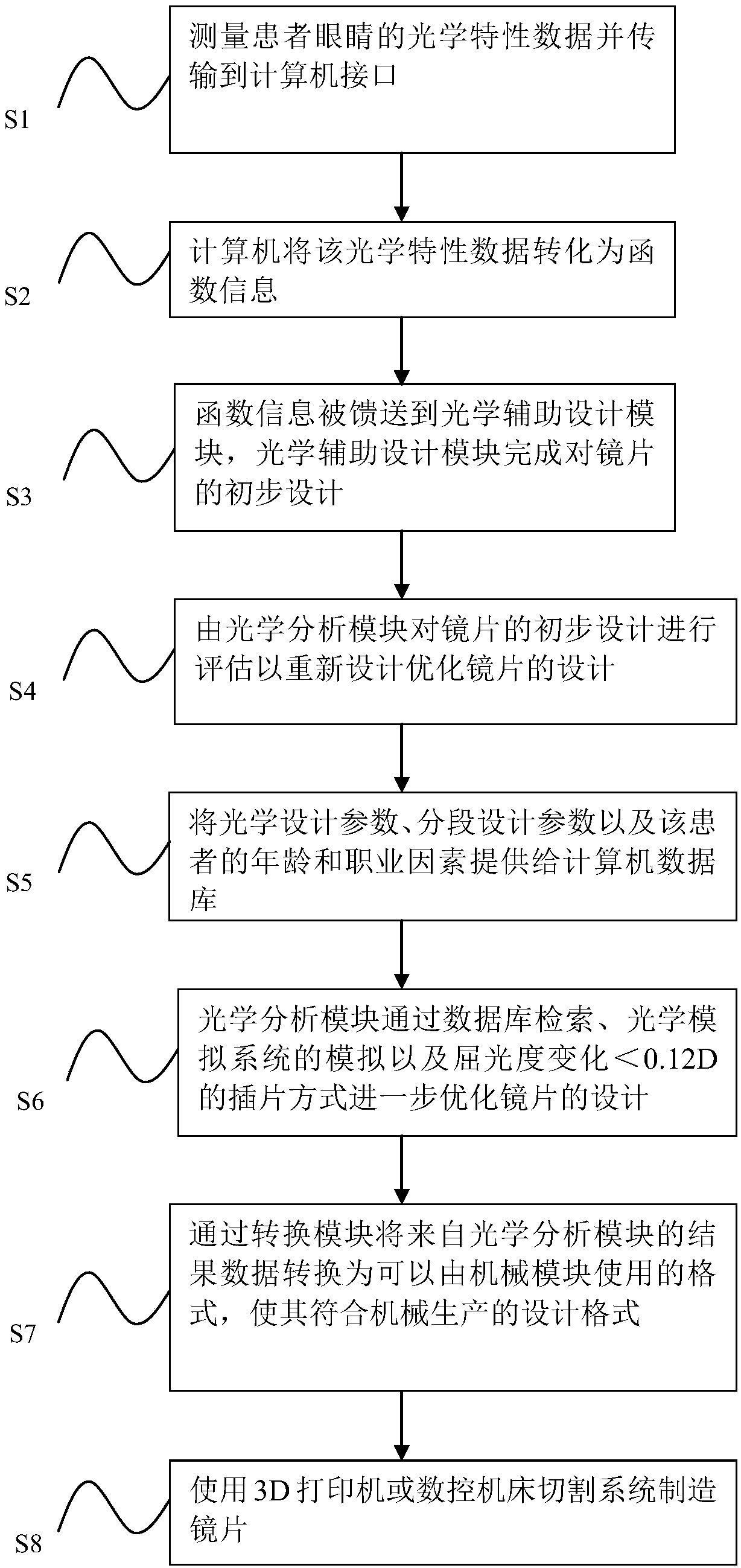Lens conforming to retina resolution ratio as well as optometry prescription and manufacturing method thereof
A manufacturing method and resolution technology, applied in glasses/goggles, optics, instruments, etc., can solve problems such as information communication errors, large manufacturing and assembly work differences, glasses that cannot meet the requirements of retinal resolution, etc., and achieve outstanding manufacturing The effect of small ability and work difference
- Summary
- Abstract
- Description
- Claims
- Application Information
AI Technical Summary
Problems solved by technology
Method used
Image
Examples
Embodiment 1
[0033] S1, Measure the optical properties of the patient's eye through a high-precision customized focal meter or wavefront sensor and generate a feature data set that is transmitted to a computer interface, including but not limited to wavefront aberration and corneal topography data for the creation of a computational model eye Foundation. Among them, the measurement accuracy of aberration is expressed as focal difference <0.06D. The high-precision customized focal meter or wavefront sensor here refers to an optical instrument that can meet the above-mentioned measurement accuracy.
[0034] S2, the computer converts the optical characteristic data into function information.
[0035] S3, the function information is fed to the optical calculation aided (CAD) design module, and the optical aided design module completes the preliminary design of the lens through the optical design software, and the design includes but is not limited to the double-sided free-form surface design ...
Embodiment 2
[0045] Example 2 - Example 4 Example 1 is further illustrated by a real fitting and manufacturing example.
[0046] Example 2
[0047] Patient 1 (44 years old), optometry data: left eye: -2.65, right eye: -2.65.
[0048] Input the optometry data into the computer, and the computer corrects the initial data according to the fact that the patient works as a clerical worker and uses his eyes at close range, and the corrected parameters are obtained as left eye: -2.53 and right eye: -2.53. For the case where the value of the diopter is less than -5.00, a material with a refractive index of 1.597 is selected for the next step of the model design process. Through the optical simulation system, the correction effect after the patient wears it is simulated, and the combination of the actual wearing and correction of the optometry film in the 5-degree change interval is used to further confirm the comfort of use.
[0049] After obtaining the final 3D model, according to the design ch...
Embodiment 3
[0051] Using the technical solution of Example 1, the best correction solution for patient 2 was obtained: left eye: -2.55, right eye: -2.55.
[0052] Use the current national standard 25-degree optometry film for optometry and correction, which can only be selected between left eye: -2.50, right eye: -2.50 or left eye: -2.75, right eye: -2.75;
[0053] Optometry and correction are performed with a 10-degree interval optometry sheet, which can only be selected between left eye: -2.50, right eye: -2.50 or left eye: -2.60, right eye: -2.60;
[0054] Using the optometry film in the 5-degree interval for optometry and correction, the optometry data can be accurately obtained and corrected as follows: left eye: -2.55, right eye: -2.55.
[0055] Medical data proves that the minimum resolution of the human eye for visual correction is 0.0625D, so a 5-degree interval will be used for optometry and correction to achieve the theoretically optimal correction plan.
PUM
 Login to View More
Login to View More Abstract
Description
Claims
Application Information
 Login to View More
Login to View More - R&D
- Intellectual Property
- Life Sciences
- Materials
- Tech Scout
- Unparalleled Data Quality
- Higher Quality Content
- 60% Fewer Hallucinations
Browse by: Latest US Patents, China's latest patents, Technical Efficacy Thesaurus, Application Domain, Technology Topic, Popular Technical Reports.
© 2025 PatSnap. All rights reserved.Legal|Privacy policy|Modern Slavery Act Transparency Statement|Sitemap|About US| Contact US: help@patsnap.com

